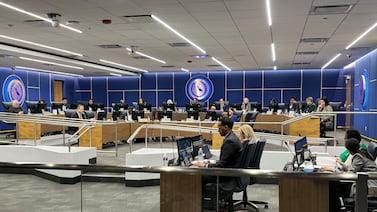Chalkbeat is a nonprofit news organization covering public education in communities across America. Sign up for our free weekly newsletter to keep up with how public education is changing.
This story was co-published with Vox.
Eric Hanushek, a leading education researcher, has spent his career arguing that spending more money on schools probably won’t make them better.
His latest research, though, suggests the opposite.
The paper, set to be published later this year, is a new review of dozens of studies. It finds that when schools get more money, students tend to score better on tests and stay in school longer, at least according to the majority of rigorous studies on the topic.
“They found pretty consistent positive effects of school funding,” said Adam Tyner, national research director at the Fordham Institute, a conservative education think tank. “The fact that Hanushek has found so many positive effects is especially significant because he’s associated with the idea that money doesn’t matter all that much to school performance.”
The findings seem like a remarkable turnabout compared to prior research from Hanushek, who had for four decades concluded in academic work that most studies show no clear relationship between spending and school performance. His work has been cited by the U.S. Supreme Court and pushed a generation of federal policymakers and advocates looking to fix America’s schools to focus not on money but ideas like teacher evaluation and school choice.
Despite his new findings, Hanushek’s own views have not changed. “Just putting more money into schools is unlikely to give us very good results,” he said in a recent interview. The focus, he insists, should be on spending money effectively, not necessarily spending more of it. Money might help, but it’s no guarantee.
Hanushek’s view matters because he remains influential, playing a dual role as a leading scholar and advocate — he continues to testify in court cases about school funding and to shape how many lawmakers think about improving schools.
‘Does money matter?’ The decades-long debate, explained.
Hanushek began studying schools as a doctoral student in economics at MIT in 1966, when he attended an academic seminar to pore over a bombshell new study. The Coleman Report, published by the federal government, claimed that schools did not matter much for students’ academic success. More money for education wouldn’t improve things either, argued the report, which was influential but shot through with methodological flaws.
Hanushek couldn’t believe the conclusion that schools didn’t matter. By 1981, then an economics professor at the University of Rochester, he had found a way to make sense of the report’s vexing findings: Schools really did make difference, but you couldn’t tell which ones were good based on how much money they spent. Hanushek published a manifesto-like academic paper laying out this case titled: “Throwing Money at Schools.”
Eventually the debate became “Does money matter?” as the Brookings Institution put it in a book that Hanushek contributed to. He always described this framing as simplistic, but Hanushek essentially became the captain of team “not really.”
Hanushek hammered home this point with the message discipline of a politician and the data chops of an economist. He wrote updated versions of the same academic paper again in 1986 and then in 1989, 1997, and 2003. He also made the case in numerous reports and articles, as well as in testimony in increasingly prevalent school funding lawsuits. In 2000, he became a fellow at Stanford University’s Hoover Institution, a conservative think tank, where he remains based today.
Hanushek’s basic claim was that most studies of school “inputs” — like per-pupil spending, teacher salaries, and smaller class sizes — did not show a clear link between those resources and student outcomes. His 2003 paper showed that only 27% of the findings on spending were positively and significantly related to student performance. “One is left with the clear picture that input policies of the type typically pursued have little chance of being effective,” Hanushek wrote.
The basis for this conclusion was far more tenuous than Hanushek let on, though. Some researchers reanalyzed Hanushek’s data, and found that there actually was a link between spending and performance because his approach for summarizing studies was flawed. More importantly, the studies he relied on weren’t able to clearly isolate the impact of money.
“They were very poorly done by current standards,” said Martin West, a Harvard education professor. Nevertheless, Hanushek’s summary of these older studies, all published before 1995, is still sometimes cited today, including in legal proceedings.
Starting in the early 1990s, the economics discipline began focusing more on teasing apart cause and effect, using so-called “natural experiments,” an idea that recently won the Nobel Prize in economics. This eventually upended the school spending debate: A slew of newer papers using these methods came out showing a positive link with student outcomes. A recent overview paper by Northwestern University’s Kirabo Jackson and Claire Mackevicius combined the results of numerous prior studies. They found that on average, an additional $1,000 per student led to small increases in test scores and a 2 percentage-point boost in high school graduation rates.
The view that money matters now appears to be conventional wisdom among education researchers, although some still question whether the newer methods can convincingly show cause and effect.
Hanushek has downplayed this newer research linking spending to outcomes. Last year he even testified in a Pennsylvania school funding case that, “The majority of the studies that have been done to look at this relationship don’t give any statistically significant relationship.” This line was later cited in a trial brief by lawyers for the state.
Hanushek’s new paper: most studies do show a link between funding, performance
Hanushek’s most recent paper, posted online several months after his Pennsylvania testimony, comes to a different conclusion.
Along with Stanford predoctoral fellow Danielle Handel, Hanushek reviewed rigorous studies released since 1999. Of 18 statistical estimates of the relationship between spending and test scores, 11 were positive and statistically significant. A separate set of 18 estimates examined the link with high school completion or college attendance; 14 of those were positive and significant. (The other four leaned positive but were not significant.) These findings appear much more favorable for school spending than Hanushek’s prior work indicated.
Hanushek and Northwestern’s Jackson have publicly debated the relationship between funding and outcomes, including in a recent Maryland court case. But their most recent papers are surprisingly aligned in results, if not interpretation.
“The findings reported by these studies were remarkably similar,” said Matthew Springer, a professor at the University of North Carolina who has testified on the side of states in a number of funding cases. Both show positive effects of money, he said.
Still, Hanushek insists this is the wrong takeaway. Don’t look at the typical effect, he argues; look at the variation from study to study. “A thorough review of existing studies ... leads to conclusions similar to those in the historical work: how resources are used is key to the outcomes,” he and Handel wrote. “The range of estimates is startling.”
The context matters, they say. Sometimes money is spent well; sometimes it’s spent poorly. Sometimes the effects are big; other times they are small or nonexistent. Just focusing on the overall effect masks this variation.
To Hanushek, this aligns with what he’s been saying for decades: Throwing money at schools is a bad bet. “I still don’t think that that’s good policy — that you have 61% of very diverse studies [finding a relationship between spending and test scores] and you say I’ll bet the next billion dollars on that,” he said.
Jackson agrees that how money is spent matters. But he also thinks that Hanushek is missing the obvious conclusion from his own results.
“The vast majority of the time whatever school districts choose to spend the money on tends to improve outcomes,” he said. “I don’t see how you can look at that and then say therefore we don’t have enough evidence to suggest we should just increase the funds.”
Other researchers agreed that the variation in results is important, but that shouldn’t mean ignoring the overall impact. “The average effect still matters,” said West, the Harvard professor.
The new research has not stopped Hanushek’s advocacy work outside of academia. He is still testifying on behalf of states in court cases about whether schools should get more money, including in ongoing lawsuits in Arizona and Maryland. (Recently, he’s been paid $450 an hour for his time in these cases. Jackson was paid $300 an hour as an expert on the other side of the Maryland case.) “More often than not the academic research indicates no significant improvements in student outcomes despite increased funding,” Hanushek wrote last year in an expert report for the Maryland case.
Now, though, Hanushek’s own work contradicts his claim that most studies don’t show a positive relationship. “When I gave that testimony, I didn’t have this summary,” Hanushek said, referring to similar comments as a witness in Pennsylvania. “I wouldn’t answer it in that way” if asked again, he said. But ultimately, his thrust would be the same: “I would say that there is no consistent effect.”
The Pennsylvania judge didn’t buy Hanushek’s claims, and ruled for plaintiffs who sued the state. Other judges and politicians may be persuaded though. Some policymakers, including former Education Secretary Betsy DeVos, continue to claim that money will not improve schools. This mantra may grow louder. Schools have received $190 billion in COVID relief since 2020, and although there has been little rigorous research on the money’s effects, many commentators have already argued that the funding has been ill spent.
Meanwhile, despite the impression left by four decades of his work and legal testimony, Hanushek says he’s not actually against more funding for schools. “I have never said that money shouldn’t be spent on schools,” he said recently. He simply thinks it needs to be used more effectively. For instance, he would like to see extra resources earmarked to attract and retain good teachers in high-poverty schools, a policy he found worked in Dallas.
So should policymakers spend more dollars on public schools, attached to certain requirements? Hanushek’s answer: “Yes.”
Matt Barnum is a Spencer fellow in education journalism at Columbia University and a national reporter at Chalkbeat.






